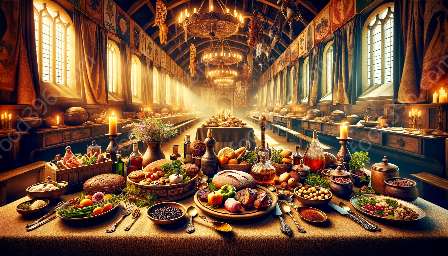During the Middle Ages, food sources and farming practices played a pivotal role in shaping the dietary habits and culinary landscape of the era. The period spanning from the 5th to the late 15th century witnessed significant developments in agricultural techniques and food production, leading to the emergence of a distinct medieval cuisine history that continues to intrigue and inspire us today. This topic cluster delves into the fascinating world of food sources and farming practices in the Middle Ages, exploring the agricultural methods, diet staples, and culinary heritage that were integral to this captivating period.
The Agrarian Lifestyle
The Middle Ages were characterized by an agrarian society, where the majority of the population relied on farming and agriculture for sustenance. The feudal system, prevalent across much of Europe during this time, saw the allocation of land to vassals in exchange for military service. This resulted in a hierarchical structure of land ownership, with wealthy nobles and feudal lords controlling vast estates worked by peasant labor.
Medieval farming practices were deeply rooted in tradition and often revolved around subsistence agriculture, with the primary goal of producing enough food to support the local community. The landscape was dotted with agricultural fields, orchards, vineyards, and grazing pastures, each serving as essential food sources for both rural and urban populations.
Ancient Techniques and Innovations
Although the Middle Ages are often perceived as a time of stagnation, agricultural practices and food sources experienced notable advancements and innovations during this period. One of the most significant developments was the widespread use of the three-field system, a rotational agricultural practice that involved dividing arable land into three fields, each planted with different crops in succession. This method not only improved soil fertility but also increased overall agricultural productivity, enabling farmers to grow a diverse range of food crops.
In addition to the three-field system, medieval farmers also utilized various agricultural techniques, such as crop rotation, irrigation, and animal husbandry, to maximize the yield from their land. The use of draft animals, including oxen and horses, for plowing and transportation further revolutionized farming practices and contributed to the expansion of arable land.
Key Food Sources
The food sources available during the Middle Ages were diverse and varied, influenced by regional differences in climate, soil fertility, and agricultural practices. Cereals formed the cornerstone of the medieval diet, with grains such as wheat, barley, oats, and rye cultivated extensively throughout Europe. These grains were used to produce bread, porridge, and ale, serving as staple foods for both the affluent and the common folk.
Fruits and vegetables also constituted essential food sources, with peas, beans, cabbage, turnips, onions, and carrots being commonly grown and consumed. Orchards yielded an assortment of fruits, including apples, pears, plums, and cherries, which were consumed fresh or preserved through drying or fermentation. Moreover, the cultivation of herbs and spices added flavor and variety to medieval cuisine, enhancing the taste of dishes and aiding in food preservation.
The Culinary Heritage
The rich array of food sources available during the Middle Ages laid the foundation for a diverse and robust culinary heritage that encompassed a wide range of dishes and preparations. The principles of seasonal eating and nose-to-tail cooking were prevalent, with medieval cooks making use of every edible part of an animal or plant to minimize waste.
Medieval cuisine history is characterized by a blend of influences, including indigenous traditions, trade connections, and the culinary legacy of the Roman Empire. The fusion of flavors, ingredients, and cooking techniques resulted in a tapestry of regional cuisines that reflected the cultural and gastronomic diversity of medieval Europe. From hearty stews and roasts to elaborate feasts and banquets, the culinary practices of the Middle Ages offered a glimpse into the social, economic, and religious dimensions of the era.
Exploring the food sources and farming practices of the Middle Ages provides valuable insights into the agricultural foundation and culinary evolution of medieval cuisine history. From the agrarian lifestyle to the cultivation of key food sources and the enduring culinary heritage, the legacy of medieval farming and food production continues to influence our understanding and appreciation of this captivating era.

